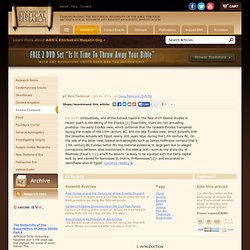

The Animals Went in Two by Two, According to Babylonian Ark Tablet. The so-called Ark Tablet, recently translated by Irving Finkel, is an Old Babylonian (1900-1700 B.C.E.) account of the flood in which the god Enki instructs Atrahasis--the Babylonian Noah--on how to build an ark.

The twist? This Babylonian ark would have been circular. We all know the story of Noah’s Ark. Ever since George Smith’s 1872 translation of Babylonian texts similar to the Biblical Deluge (see “George Smith’s Other Find” below), we’ve also known about echoes of the Genesis narrative in pre-Biblical Mesopotamian texts. Israeli scholar completes mission to 'fix' Bible. RAMAT GAN, Israel (AP) — For the past 30 years, Israeli Judaic scholar Menachem Cohen has been on a mission of biblical proportions: Correcting all known textual errors in Jewish scripture to produce a truly definitive edition of the Old Testament.

His edits, focusing primarily on grammatical blemishes and an intricate set of biblical symbols, mark the first major overhaul of the Hebrew Bible in nearly 500 years. Poring over thousands of medieval manuscripts, the 84-year-old Cohen identified 1,500 inaccuracies in the Hebrew language texts that have been corrected in his completed 21-volume set. The final chapter is set to be published next year. The Bible Unearthed 3. The Kings. The Dating of Hazor's Destruction in Joshua 11 Via Biblical, Archaeological, and Epigraphical Evidence. On the side of the former view, biblical archaeologists such as Bryant Wood argue that the Exodus must have occurred in the middle of the 15th century BC, since the ordinal number “480th” in 1 Kgs 6:1 only can be understood literally (contra allegorically, as late-Exodus proponents suggest).

Wood, who mainly presents archaeological evidence to support his case, even declares that “the 13th-century Exodus-Conquest model is no longer tenable.”[3] Thus the battle over the proper dating of the Exodus and Conquest continues to wage. While this debate cannot be settled in the present article, nor can space be devoted here to the issue of the alleged Ramesside connections with the store-city of Raamses or the problem of archaeology not being able to “provide any trace of Israelites [in Canaan] before the Iron Age (shortly before 1200 B.C.E.),”[4] an examination of one aspect of this issue is in order: namely, the destruction of Hazor that is recorded in Joshua 11. 1. 2. 1.
The Bible Unearthed. The Bible Unearthed: Archaeology's New Vision of Ancient Israel and the Origin of Its Sacred Texts[1] is a 2001 book about the archaeology of Israel and its relationship to the origins of the Hebrew Bible.

The authors are Israel Finkelstein, Professor of Archaeology at Tel Aviv University, and Neil Asher Silberman, a contributing editor to Archaeology Magazine. Methodology[edit] The Bible Unearthed 1. The Patriarchs. The Bible Unearthed 2. The Exodus. The Bible Unearthed 4. The Book. Domesticated Camels in the Book of Genesis. Dead Sea Scrolls. “Light” in Isa 53.11 and its possible effect upon Christian Resurrection Theology. Here’s a brief comparison of three translations of Isaiah 53.11 ESV: Out of the anguish of his soul he shall see and be satisfied; by his knowledge shall the righteous one, my servant, make many to be accounted righteous, and he shall bear their iniquities.

RSV: he shall see the fruit of the travail of his soul and be satisfied; by his knowledge shall the righteous one, my servant, make many to be accounted righteous; and he shall bear their iniquities. NRSV: Out of his anguish he shall see light; he shall find satisfaction through his knowledge. The righteous one, my servant, shall make many righteous, and he shall bear their iniquities. In translating the verse there is some debate as to what the Servant sees: (1) the fruit of his work (KJV, NKJV, RSV), (2) “light” meaning life, resurrection, vindication etc (NRSV, NIV, NJB), or (3) something unspecified (ESV).
In Jewish literature of the second-temple era it was possible to regard “light” as a catchword for “resurrection life”. 09-05-26 16:23 Topics: Old Blog By: Jeremy In the previous post, I discussed how the manuscripts of Jeremiah found among the Dead Sea Scrolls can aid us in taking a more moderate approach to the reliability of the Old Testament documents.

And, in this post, I will discuss the fact that even information from the Great Isaiah Scroll, which is often used to “prove” the reliability of Old Testament documents, might also lead to a more moderate approach. It is often cited that the Great Isaiah Scroll (which you can get a very good look at on the Dorot Foundation site) is 95% the same as the Masoretic Text (MT) with this statistic being astounding since over 1,000 years separate the MT from the Great Isaiah Scroll.
In addition, it is often pointed out that differences are primarily in spelling and in individual words. The Great Isaiah Scroll in fact presents us with (at least) one such occasion in which knowledge of an individual word could be significant. I typically do not pay a great deal of attention to Christian apologetic literature because I realize that it routinely oversimplifies matters.

However, I had recently finished an audio course on the Dead Sea Scrolls when I came across a video on the reliability of Old Testament documents. According to the video, the Great Isaiah Scroll that was found among the texts at Qumran demonstrates the reliability of Old Testament documents. In other words, the Dead Sea Scrolls show that the Masoretic Text (the text used for modern English translations of the Bible) is reliable in the sense that it is extremely close to the original words that were written by Isaiah or any other Biblical author for that matter. It was at this point that I thought this could be a useful teaching opportunity. Septuagint Authority: Augustine vs Jerome. Introduction to the Apocrypha and the Septuagint - Part One. Introduction to the Apocrypha and the Septuagint - Part Two.